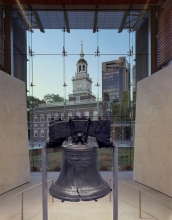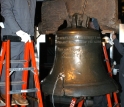|

Press Release 06-099
Protecting the Liberty Bell

July 3, 2006
On July 4th, many Americans will travel hundreds of miles to visit the Liberty Bell in Philadelphia. But at this time in 2003, the bell was getting ready for its own trip--roughly 200 yards from its existing location into a new museum. Moving the 250-year-old bell over even that short a distance, however, might have caused a catastrophic break. NSF-supported engineers proved critical to keeping the icon safe.
A long, hairline fracture extends from the Liberty Bell's famous crack, and the National Park Service was worried that the fracture could split open during the stresses of the move. But they wouldn't know unless they could find a way to measure accurately extremely tiny movements in the metal as the 2,000-pound bell was raised. Engineer Steve Arms and his colleagues from MicroStrain, Inc. in Williston, Vt., had developed tiny, wireless motion sensors with the help of NSF funding, and the bell's handlers realized that the devices would be perfect for warning of dangerous motion along the crack on moving day.
During a test lift, as the famous bell was gingerly lifted a few inches off its mount, the engineers used customized versions of their sensors to carefully measure strain on the metal, information that the team then used to monitor the bell closely as it eventually, and safely, made its journey on Oct. 8 to its present home at the new Liberty Bell Center.
-NSF-

Media Contacts
Joshua A. Chamot, NSF (703) 292-7730 jchamot@nsf.gov
Jane Cowley, Independence National Historical Park (215) 597-0060 Jane_Cowley@nps.gov
Program Contacts
Kesh S. Narayanan, NSF (703) 292-7076 knarayan@nsf.gov
Related Websites
MicroStrain, Inc. Website: http://www.microstrain.com
Official National Park Service Web site on the Liberty Bell: http://www.nps.gov/inde/liberty-bell.html
NSF Special Report: The Liberty Bell - Protecting an American Icon: http://www.nsf.gov/news/special_reports/liberty/

The National Science Foundation (NSF) is an independent federal agency that supports fundamental research and education across all fields of science and engineering. In fiscal year (FY) 2009, its budget is $9.5 billion, which includes $3.0 billion provided through the American Recovery and Reinvestment Act. NSF funds reach all 50 states through grants to over 1,900 universities and institutions. Each year, NSF receives about 44,400 competitive requests for funding, and makes over 11,500 new funding awards. NSF also awards over $400 million in professional and service contracts yearly.
 Get News Updates by Email Get News Updates by Email
Useful NSF Web Sites:
NSF Home Page: http://www.nsf.gov
NSF News: http://www.nsf.gov/news/
For the News Media: http://www.nsf.gov/news/newsroom.jsp
Science and Engineering Statistics: http://www.nsf.gov/statistics/
Awards Searches: http://www.nsf.gov/awardsearch/
| 



